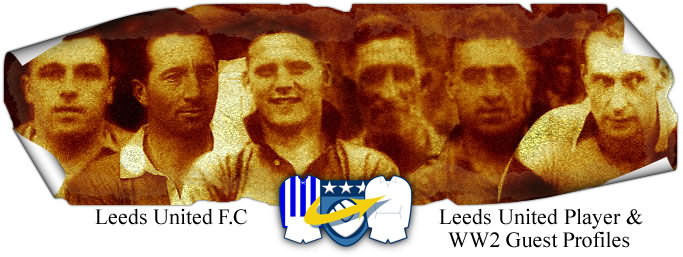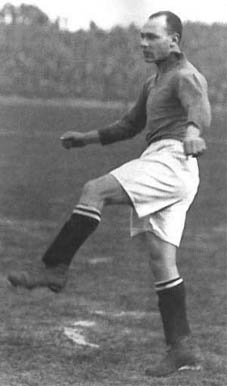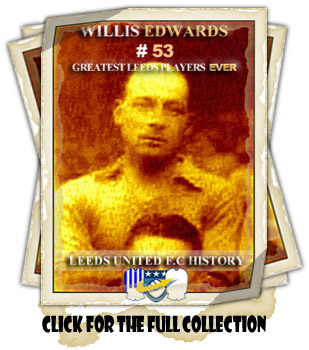

Edwards: Willis
1925-1939 & WW2 Guest: 1939-1943
(Player Details)
(Leeds United War-time Guest Player Details)
Right Half
Born: Newton, Nr Alfreton: 28-04-1903
Debut v Newcastle United (a): 21-03-1925
5’8” 11st 9lb (1930)
#53 in 100 Greatest LUFC Players Ever

He became Leeds United’s first ever international when he played for England against
Wales at Selhurst Park on 1st March 1926. He was a big-money player, renowned as the best
wing-half of the era, when Leeds signed him for £1,500 from Chesterfield. He went straight
into the first team and, barring the odd spell out with injury, made the Number Four shirt
his own until the outbreak of World War Two. In that time he went on to collect sixteen
England caps, and represent the Football League eleven times, and might have had a lot more
had not the Second World War Intervened. However, even in War-time he kept on turning out
for Leeds. After the War, from April 1947, he spent a year as Manager before becoming one
of the club's back-room staff for a decade. Born at Newton, near Alfreton, in North East
Derbyshire, like most young men of the area became a coal miner, as soon as his schooldays
were over. He also started to make a name for himself as a right-half with the local
football team, Newton Rangers. Blackburn Rovers, one of the top teams of the day, had
noted his promise and invited him for a trial at Ewood Park. His local major club,
Chesterfield, who had just regained their Football League status, with the inauguration of
the Third Division North, beat their First Division rivals to the punch and paid out £10
in February 1922, to take him to Saltergate. They also offered him thirty shillings per
week and to the teenage Edwards it represented a lot of money. However, it was a smart
piece of business by the Spireites as they had acquired the services of a player who just
four years later would play for England. To their credit they did not rush the young star,
but rather than that they eased him into the team, and with careful development and
handling his promise was fulfilled. It would have been easy to put the teamm's interest
first by playing him constantly, but they kept resting him so not to overstretch him as
he developed into a strong thoughtful right-half, who soon had scouts from bigger clubs
watching his every move. One such club was Leeds United, who were prepared to take the risk
and sign him, while others like Sheffield United thought he was too small to make the grade.
He scored once in seventy League games while with Chesterfield. Leeds paid £1500 for him in
March 1925, which set a new record for a sale by Chesterfield. He went straight into the
Leeds first team along with Russell Wainscoat who had also bought in the same week to join
Tom Jennings, who had arrived from Raith Rovers a couple of weeks previous. The three were
to have a big hand in the fortunes of the club in the next few years. Initially they
combined to stave off the threat of relegation, but four wins in the final nine games
achieved that. 1925-26 saw United in nineteenth spot and the following season they could
not avoid the drop despite thirty-five goals from Tom Jennings. 1927-28 saw United
runners-up in the Second Division and that meant an immediate return to the top flight.
1930-31 saw the arrival of Wilf Copping and the start of the famous Edwards-Hart-Copping
half back line, but it could not stave off relegation. However 1931-32 saw United once
more runners-up in Division Two and ensured a speedy return to the top flight. The
triumvirate continued until Wilf Copping was sold to Arsenal after the 1933-34 season.
Edwards was acknowledged as the best right half in Britain and he had only been with
United for a year, when he was picked for England to play Wales at Selhurst Park on 1st
March 1926. it was not a happy debut as the Welsh triumphed 3-1.He retained his spot for
the next game against Scotland on 17th April 1926 against Scotland at Old Trafford which
also saw the visitors win 1-0. He missed the next game against Belgium as England took the
chance to give others a chance and Sam Cowan of Manchester City was given his debut in the
Friendly International. Edwards was back for the next match a 3-3 draw with Northern
Ireland at Anfield on 20th October 1926. The game saw George Brown, then of Huddersfield
Town, and later of Leeds United, and Goalkeeper Albert McInroy, then of Sunderland and also
later of Leeds United make their debuts. Brown was quick off the mark with a goal after
eight minutes, but not as quick as Billy Gillespie, then of Sheffield United, but formerly
of Leeds City, who had already found the net in the fifth minute. His fourth Cap came in
another 3-3 draw, this time with Wales on 12th February 1927 at Wrexham, with George Brown
getting his second cap. England's next fixture was at Hampden Park on 2nd April 1927 and two
goals from Dixie Dean, making his second England appearance was enough to ensure a 2-1 win
for England. With five caps, Edwards was now England's most experienced player and Brown got
his third cap. England's next match was a friendly in Brussels against Belgium, which saw the
floodgates open as England hammered the Belgians to the tune of 9-1 to help Edwards celebrate
his sixth cap as George Brown scored twice to celebrate his fourth cap and Dixie Dean helped
himself to a hat-trick. England were on a European tour and the next game was at Stade de la
Frontiere, Esch-Uelzecht, where Luxembourg were put to the sword to the tune of 5-2. For
Edwards it was cap number seven, for Brown it was number five and Dixie Dean celebrated his
fourth cap with another hat-trick. Five days later England were at the Stade Olympique de
Colombes, Paris to give France a 6-0 pasting as Edwards made it eight, Brown six and Dean
five with Brown and Dean both bagging two goals each. Edwards missed the two next England
games, a 0-2 loss in Belfast against Northern Ireland on 22nd October 1927 and a 1-2 loss at
Burnley against Wales on 28th November 1927, due to injury, which had seen him miss eight
games for United in that time. His ninth cap duly arrived on 31st March 1928 as Scotland
became the "Wembley Wizards" to inflict a painful 1-5 defeat. His tenth cap held much happier
memories, at Stade Olympique Yves-du-Manoir, Colombes, Paris, when they beat the French 5-1
on 17th May 1928. This was quickly followed, two days later with a 3-1 win at Olympisch
Stadion (Kielstadion), Antwerp over Belgium. His final five caps for England were all as captain.
His twelfth coming on 22nd October 1928 in a 2-1 win against Northern Ireland at Goodison Park
and his thirteenth came on 17th November 1928, when Ernie Hart made his England debut at
centre-half in a 3-2 win over wales at the Vetch Field, Swansea. On 13th April 1929 he led out
his team, in his fourteenth international, as Russell Wainscoat made his England debut at
Hampden Park, Glasgow, as Scotland clinched the Home Championship with a last minute goal from
Alex Cheyne. He missed the European tour in the close season as England beat France 4-1 in Paris,
Belgium 5-1 in Brussels, but went down to Spain 3-4 in Madrid. He was back to lead the team on
19th October 1929 in a 3-0 win over Northern Ireland at Windsor Park, Belfast as his teammates
Ernie Hart made his second England appearance at centre-half and Harry Duggan played at outside
right for Northern Ireland. His sixteenth and final cap saw him lead his team, with Ernie Hart
making his third England appearance at centre half in a 6-0 win over Wales at Stamford Bridge on
20th November 1929. While Ernie Hart came back to win five more England caps, it was Edwards'
final game for England and the triumvite of Edwards-Hart-Copping was never called into action by
England. He was viewed by his fellow professionals as a fine all-round player, firm on the ball
but light on his feet and accurate with his passes. He possessed remarkable ball-control, fine
heading skills and was the master of the long pinpoint pass. He was also famous for a remarkable
piece of skill. While playing for United at Elland Road, instead of heading out of defence,
Edwards performed a handstand and back-heeled the ball away. After finishing his England career
he still performed well and regularly through the heights and troughs of the almost unpredictable
fortunes of Leeds United. He missed all but two games in the first half ofthe 1932-33 season, but
was then ever-present for the rest of the season. He was again troubled by injuries in the 1933-34
season and finished with only fifteen appearances for the season. 1934-35 saw him out for fourteen
consecutive games from the early games of the 1934-35 season, but when he returned he did not miss
a game from then until the end of the season. He only missed three games in 1935-36 and seven in
1936-37, but 1937-38 saw him only play three games. However, his playing days were coming to an
end, and although he played twenty times in 1938-39, three with Wilf Copping after his return, the
Second World War ensured those would be his last as a player in the Football League. Edwards
continued playing in emergencies until 1943, when he was almost forty. In the wartime he played
twice in the League and twice in the Cup in the 1939-40 season, his first War-time game being
against Newcastle United in a 0-3 away defeat on 6th January 1940. He then played sixteen League
and three Cupgames scoring a goal in each competition in the 1940-41 season. He played his final
game forLeeds on 13th February 1943 in the 1942-43 season Football League Northern Section
(Second Championship) at Right Half in a 2-2 draw at home to Bradford Park Avenue. Following his
retirement from playing, Edwards became Assistant to Trainer Bob Roxburgh, with responsibility for
the Reserve team. In April 1947, Leeds were relegated after a disastrous season and Manager Billy
Hampson was sacked. Edwards was asked to take his place with a handful of games left that season
and set about the task of building a team good enough to win back United's Division One status as
quickly as possible. Edwards worked hard on improving the fitness and skills of his squad, but it
was to no avail as the slide continued. He seemed powerless to stop a season long struggle against
relegation to the Third Division and muddled through most of his reign. He was a benign man with a
wonderful playing pedigree, but lacked the brutish drive to dismantle and reconstruct a team that
was in such poor shape. Full-back Jimmy Dunn sensed Edwards’ uncertainty and a lack of conviction.
"He seemed to be picking the team with the Directors and Trainer. I think he was just a figurehead;
not management material. There was a sense of the club drifting." Eventually Leeds managed to
secure their Second Division survival with an eighteenth place finish. The Board finally accepted
Edwards' unsuitability for the role of Manager and immediately demoted him back to the role of
Assistant Manager after only twelve months as Manager. He had not been a success and was thought to
be a pawn of the Leeds board. Edwards was undoubtedly a strong and gifted footballer and leader on
the field but he did not have the necessary strength of character and ruthless streak off the field
to succeed and was clearly out of his depth. An experienced and colourful replacement was found in
Major Frank Buckley, who left Hull City to take control at the end of the season. His autocratic and
no nonsense attitude was in stark contrast to the more gentlemanly approach that Edwards had brought
to the role. His demotion and the traumas of the struggle did not damage Edwards' love for the club,
however, and he remained a loyal member of the backroom team for well over a decade, stretching his
association with Leeds to thirty-five years. He died in October 1988 in Leeds, aged eighty-five,
having spent the last years of his working life employed in a jam factory.